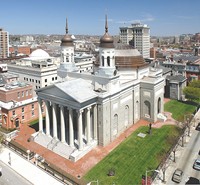Neoclassical Art
Definition, Characteristics, History of
Neoclassicism.
MAIN A-Z INDEX - A-Z of ART MOVEMENTS
|
Neoclassical Art |
|
NEOCLASSICISTS |
Neoclassical Art (Flourished 1770-1830)Contents • Summary |
 Baltimore Basilica (1806-21). Influential example of American neoclassical architecture, designed by the famous 19th-century architect Benjamin Latrobe. |
|
PAINTING COLOURS EVOLUTION
OF VISUAL ART ART OF ANTIQUITY |
The artistic style known as "Neoclassicism" (also called "classicism")was the predominant movement in European art and architecture during the late 18th and early 19th centuries. It reflected a desire to rekindle the spirit and forms of classical art from ancient Greece and Rome, whose principles of order and reason were entirely in keeping with the European Age of Enlightenment. Neoclassicism was also, in part, a reaction against the ostentation of Baroque art and the decadent frivololity of the decorative Rococo school, championed by the French court - and especially Louis XV's mistress, Madame de Pompadour - and also partly stimulated by the discovery of Roman ruins at Herculaneum and Pompeii (1738-50), along with publication in 1755 of the highly influential book Thoughts on the Imitation of Greek Works of Art, by the German art historian and scholar Johann Winckelmann (1717-68). All this led to a revival of neoclassical painting, sculpture and architectural design in Rome - an important stopover in the Grand Tour - from where it spread northwards to France, England, Sweden and Russia. America became very enthusiastic about Neoclassical architecture, not least because it lent public buildings an aura of tradition and permanence. Neoclassical painters included Anton Raphael Mengs (1728-79), Jacques-Louis David (1748-1825), Angelica Kauffmann (1741-1807) and Jean-Auguste-Dominique Ingres (1780-1867); while sculptors included Jean-Antoine Houdon (1741-1828), John Flaxman (1755-1826), Antonio Canova (1757-1822), and Bertel Thorvaldsen (1770-1844). Among the best known exponents of neoclassical architecture were Jules-Hardouin Mansart (1646-1708), Jacques Germain Soufflot (1713-80), Claude Nicolas Ledoux (1736-1806), John Nash (1752-1835), Jean Chalgrin (1739-1811), Carl Gotthard Langhans (1732-1908), Karl Friedrich Schinkel (1781-1841), and Benjamin Henry Latrobe (1764-1820).
|
|
|
The revival of artistic canons from Classical Antiquity was not an overnight event. It built on Renaissance art itself, as well as the more sober styles of Baroque architecture, the mood of Enlightenment, the dissatisfaction with the Rococo, and a new respect for the earlier classical history painting of Nicolas Poussin (1593-1665), as well as the classical settings of Claude Lorrain's (1600-82) landscapes. Furthermore, it matured in different countries at different times. Neoclassical architecture actually originated around 1640, and continues to this day. Paradoxically, the abundance of ancient classical buildings in Rome meant that the city at the heart of the neoclassicism movement experienced little neoclassical architecture. In addition, despite appearances, there is no clear dividing line between Neoclassicism and Romanticism. This is because a revival of interest in Classical Antiquity can easily morph into a nostalgic desire for the past. Neoclassicism - Characteristics Neoclassical works (paintings and sculptures) were serious, unemotional, and sternly heroic. Neoclassical painters depicted subjects from Classical literature and history, as used in earlier Greek art and Republican Roman art, using sombre colours with occasional brilliant highlights, to convey moral narratives of self-denial and self-sacrifice fully in keeping with the supposed ethical superiority of Antiquity. Neoclassical sculpture dealt with the same subjects, and was more restrained than the more theatrical Baroque sculpture, less whimsical than the indulgent Rococo. Neoclassical architecture was more ordered and less grandiose than Baroque, although the dividing line between the two can sometines be blurred. It bore a close external resemblance to the Greek Orders of architecture, with one obvious exception - there were no domes in ancient Greece. Most roofs were flat.
Founders and famous artists of Neoclassicism include the German portraitist and historical painter Anton Raphael Mengs (1728-79), the Frenchman Joseph-Marie Vien (1716-1809) (who taught J-L David), the Italian portrait painter Pompeo Batoni (1708-87),the Swiss painter Angelica Kauffmann (1741-1807), the French political artist Jacques-Louis David (1748-1825), and his pupils Jean-Germain Drouais (1763-88), Anne-Louis Girodet de Roucy-Trioson (1767-1824), J.A.D. Ingres (1780-1867) the French master of academic art, and the American expatriate Benjamin West (1738-1820). In Britain, celebrated followers of Neoclassicism included: Sir Joshua Reynolds and the Irish virtuoso James Barry. The most recent phase of neoclassicism - the Classical Revival in modern art - emerged between about 1900 and 1930, with active participants including Pablo Picasso (1881-1973), Fernand Leger (1881-1955) and Giorgio de Chirico (1888-1978). Famous Neoclassical Paintings • Anton Raphael Mengs Leading Neoclassical sculptors include Antonio Canova (1757-1822) who sculpted for Popes and Napoleon; the Englishman John Flaxman (1755-1826) who also designed Jasperware for Wedgwood; the Danish artist Bertel Thorvaldsen (1770-1844) known for his Jason with the Golden Fleece (1802-3, Thorvaldsen Museum, Copenhagen); and Jean-Antoine Houdon (1741-1828), best known for his portrait busts in marble. Famous Neoclassical Sculptures • Franz
Xaver Messerschmidt (1736-1783) France Famous Neoclassical Buildings - Pantheon, Paris (1756-97) by Jacques
Germain Soufflot.
|
|
• For other art movements and periods,
see: History of Art. ENCYCLOPEDIA OF ART HISTORY |